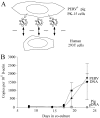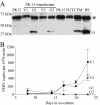The restriction of zoonotic PERV transmission by human APOBEC3G
- PMID: 17849022
- PMCID: PMC1963317
- DOI: 10.1371/journal.pone.0000893
The restriction of zoonotic PERV transmission by human APOBEC3G
Abstract
The human APOBEC3G protein is an innate anti-viral factor that can dominantly inhibit the replication of some endogenous and exogenous retroviruses. The prospects of purposefully harnessing such an anti-viral defense are under investigation. Here, long-term co-culture experiments were used to show that porcine endogenous retrovirus (PERV) transmission from pig to human cells is reduced to nearly undetectable levels by expressing human APOBEC3G in virus-producing pig kidney cells. Inhibition occurred by a deamination-independent mechanism, likely after particle production but before the virus could immortalize by integration into human genomic DNA. PERV inhibition did not require the DNA cytosine deaminase activity of APOBEC3G and, correspondingly, APOBEC3G-attributable hypermutations were not detected. In contrast, over-expression of the sole endogenous APOBEC3 protein of pigs failed to interfere significantly with PERV transmission. Together, these data constitute the first proof-of-principle demonstration that APOBEC3 proteins can be used to fortify the innate anti-viral defenses of cells to prevent the zoonotic transmission of an endogenous retrovirus. These studies suggest that human APOBEC3G-transgenic pigs will provide safer, PERV-less xenotransplantation resources and that analogous cross-species APOBEC3-dependent restriction strategies may be useful for thwarting other endogenous as well as exogenous retrovirus infections.
Conflict of interest statement
Figures





Similar articles
-
Human-APOBEC3G-dependent restriction of porcine endogenous retrovirus replication is mediated by cytidine deamination and inhibition of DNA strand transfer during reverse transcription.Arch Virol. 2018 Jul;163(7):1907-1914. doi: 10.1007/s00705-018-3822-x. Epub 2018 Apr 2. Arch Virol. 2018. PMID: 29610985
-
Differential sensitivity of porcine endogenous retrovirus to APOBEC3-mediated inhibition.Arch Virol. 2015 Aug;160(8):1901-8. doi: 10.1007/s00705-015-2450-y. Epub 2015 May 29. Arch Virol. 2015. PMID: 26016442
-
The International Xenotransplantation Association consensus statement on conditions for undertaking clinical trials of porcine islet products in type 1 diabetes--chapter 5: Strategies to prevent transmission of porcine endogenous retroviruses.Xenotransplantation. 2009 Jul-Aug;16(4):239-48. doi: 10.1111/j.1399-3089.2009.00544.x. Xenotransplantation. 2009. PMID: 19799764
-
Repression of porcine endogenous retrovirus infection by human APOBEC3 proteins.Biochem Biophys Res Commun. 2011 Apr 1;407(1):266-70. doi: 10.1016/j.bbrc.2011.03.023. Epub 2011 Mar 23. Biochem Biophys Res Commun. 2011. PMID: 21396348
-
Xenotransplantation and pig endogenous retroviruses.Rev Med Virol. 2003 Sep-Oct;13(5):311-29. doi: 10.1002/rmv.404. Rev Med Virol. 2003. PMID: 12931341 Review.
Cited by
-
Infection barriers to successful xenotransplantation focusing on porcine endogenous retroviruses.Clin Microbiol Rev. 2012 Apr;25(2):318-43. doi: 10.1128/CMR.05011-11. Clin Microbiol Rev. 2012. PMID: 22491774 Free PMC article. Review.
-
Retroelements versus APOBEC3 family members: No great escape from the magnificent seven.Front Microbiol. 2012 Aug 14;3:275. doi: 10.3389/fmicb.2012.00275. eCollection 2012. Front Microbiol. 2012. PMID: 22912627 Free PMC article.
-
Restriction of porcine endogenous retrovirus by porcine APOBEC3 cytidine deaminases.J Virol. 2011 Apr;85(8):3842-57. doi: 10.1128/JVI.01880-10. Epub 2011 Feb 9. J Virol. 2011. PMID: 21307203 Free PMC article.
-
Different modes of retrovirus restriction by human APOBEC3A and APOBEC3G in vivo.PLoS Pathog. 2014 May 22;10(5):e1004145. doi: 10.1371/journal.ppat.1004145. eCollection 2014 May. PLoS Pathog. 2014. PMID: 24851906 Free PMC article.
-
Absence of replication of porcine endogenous retrovirus and porcine lymphotropic herpesvirus type 1 with prolonged pig cell microchimerism after pig-to-baboon xenotransplantation.J Virol. 2008 Dec;82(24):12441-8. doi: 10.1128/JVI.01278-08. Epub 2008 Oct 1. J Virol. 2008. PMID: 18829759 Free PMC article.
References
Publication types
MeSH terms
Substances
LinkOut - more resources
Full Text Sources
Other Literature Sources
Medical

